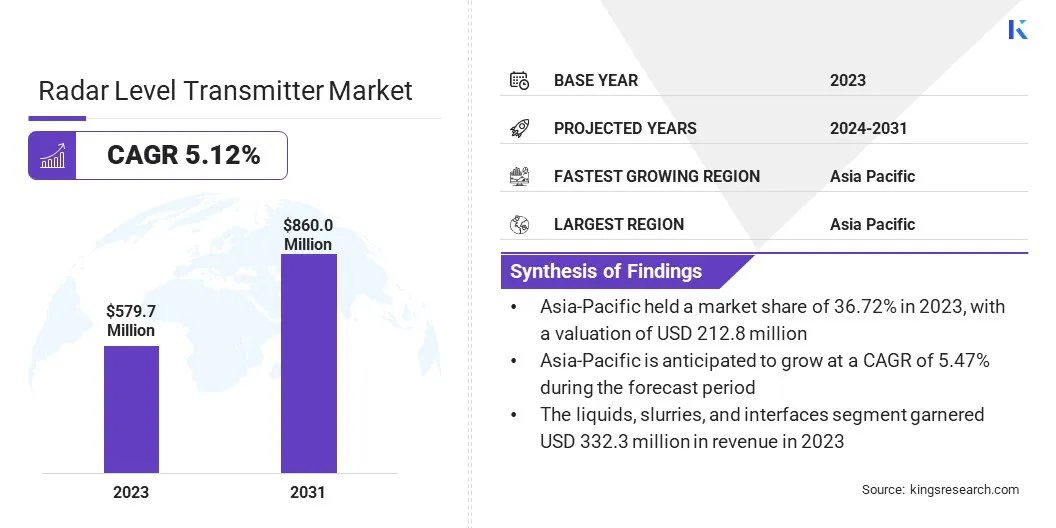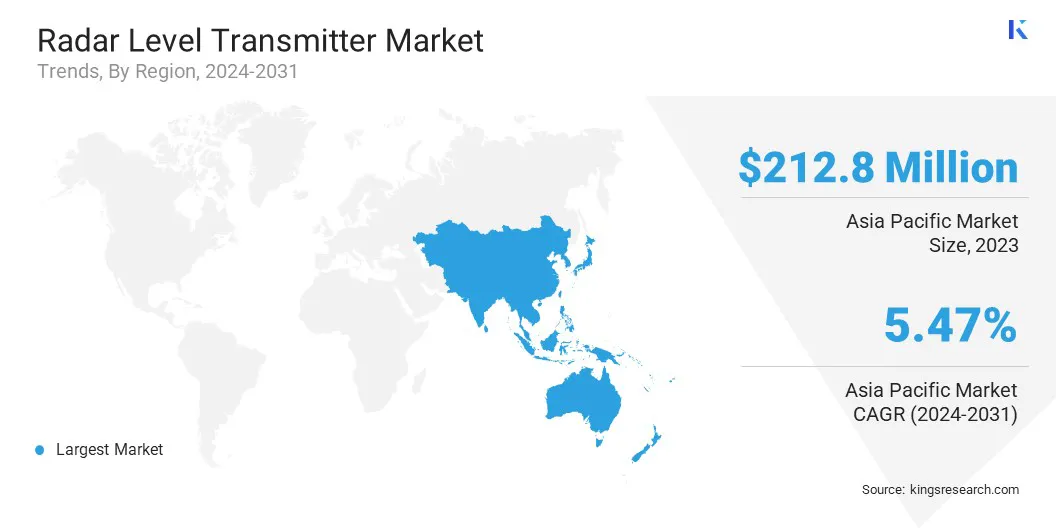Market Definition
A radar level transmitter is used to determine the level of a substance (usually a liquid or solid) within a container, tank, or vessel. It works based on radar waves (microwaves) to measure the distance to the surface of the substance.
Radar transmitters commonly operate in C and X Band (4–12 GHz), K Band (18–27 GHz), and W Band (75–110 GHz), for precision measurement. The report offers a thorough assessment of the key factors driving market expansion, along with detailed regional analysis and the competitive landscape influencing industry dynamics.
Radar Level Transmitter Market Overview
The global radar level transmitter Market size was valued at USD 579.7 million in 2023, which is estimated to be valued at USD 606.2 million in 2024 and reach USD 860.0 million by 2031, growing at a CAGR of 5.12% from 2024 to 2031.
Increasing automation across industries like oil & gas, chemicals, and water treatment is driving the demand for precise and reliable level measurement solutions. Radar level transmitters provide real-time, accurate data, enhancing process control and reducing operational risks.
Major companies operating in the radar level transmitter industry are Honeywell International Inc., Siemens, Emerson Electric Co., Endress+Hauser Group Services AG, ABB, Yokogawa Electric Corporation, AMETEK Magnetrol USA, LLC., Schneider Electric, STRONG M&C INC., Nagman, PUNE TECHTROL PRIVATE LIMITED, DAVISON INSTRUMENTS PVT. LTD, Bombay Instrument Mfg. Co, VEGA, and Trumen.
The rise of smart cities is driving significant demand for advanced monitoring systems, particularly in the management of water tanks, sewage networks, and public utility infrastructure.
Radar level transmitters offer a reliable, non-contact solution for accurate, real-time monitoring of liquid levels in water reservoirs, wastewater systems, and other utility assets. As smart cities focus on sustainability, efficient resource usage, and seamless operations, the relevance of precise, low-maintenance measurement technologies becomes critical.
Radar level transmitters play a key role in enhancing the efficiency and reliability of urban infrastructure, ensuring that essential services operate without interruption in these connected ecosystems.

Key Highlights
- The radar level transmitter industry size was recorded at USD 579.7 million in 2023.
- The market is projected to grow at a CAGR of 5.12% from 2024 to 2031.
- Asia Pacific held a market share of 36.72% in 2023, with a valuation of USD 212.8 million.
- The non-contact segment garnered USD 338.9 million in revenue in 2023.
- The liquids, slurries, and interfaces segment is expected to reach USD 498.5 million by 2031.
- The C and X Band segment held a market of 48.12% in 2023.
- The oil and gas segment is anticipated to grow at a CAGR of 5.73% during the forecast period.
- Europe is anticipated to grow at a CAGR of 5.26% during the forecast period.
Market Driver
"Increasing Automation in Industries"
As industries like oil & gas, chemicals, and water treatment are increasingly adopting automation, the need for precise and reliable level measurement becomes crucial. Radar level transmitters offer a non-contact, highly accurate solution to ensure optimal performance and safety.
In automated systems, real-time monitoring of tank levels, liquid storage, and process vessels is vital for maintaining efficiency, minimizing downtime, . The demand for such technologies is growing rapidly as companies aim to enhance operational reliability, reduce manual intervention, and improve overall productivity.
- In September 2024, SKE showcased its advanced 80GHz radar level sensors and ultrasonic level transmitters at the ECWATECH exhibition in Moscow. SKE's innovative solutions address water resource management, wastewater treatment, and environmental sustainability, positioning the company as a significant player in the high-frequency radar sensor instruments.
Market Challenge
"Complex Installation and Calibration"
A key challenge in the radar level transmitter market is the complex installation and calibration process, particularly for specialized applications in industries like oil & gas or chemicals. These systems require expertise to ensure accurate setup and optimal performance.
To address this, manufacturers are increasingly offering user-friendly installation guides, remote calibration options, and providing on-site support through trained professionals.
Additionally, advancements in wireless technology and smart sensors enable easier integration and remote diagnostics, reducing installation complexities and ensuring long-term reliability.
Market Trend
"Customization and Flexibility in Applications"
Customization and flexibility in applications is one of the key trends in the radar level transmitter market. Manufacturers are increasingly tailoring radar sensors for specific industries such as sewage, water treatment, and granulate solids, enabling precise measurements in varied conditions.
These customizable solutions address diverse needs, including complex tasks like flow monitoring and chemical containment. This trend allows industries to optimize operations, and improve accuracy and reliability, ensuring radar transmitters meet the demands of different environments and processes.
- In July 2024, KROHNE launched the OPTIWAVE 15xx series, featuring 80 GHz radar technology with HART and Bluetooth features. These compact radar level transmitters offer a cost-effective solution for liquids and solids, equipped with an intuitive setup wizard for easy configuration via mobile app or HART.
Radar Level Transmitter Market Report Snapshot
|
Segmentation
|
Details
|
|
By Technology
|
Contact, Non-Contact
|
|
By Application
|
Liquids, slurries, and interfaces, Solids
|
|
By Frequency Range
|
C and X Band, K Band, W Band
|
|
By End-User Industry
|
Oil and Gas, Chemicals and Petrochemicals, Water and Wastewater, Food and Beverages, Others
|
|
By Region
|
North America: U.S., Canada, Mexico
|
|
Europe: France, UK, Spain, Germany, Italy, Russia, Rest of Europe
|
|
Asia-Pacific: China, Japan, India, Australia, ASEAN, South Korea, Rest of Asia-Pacific
|
|
Middle East & Africa: Turkey, U.A.E, Saudi Arabia, South Africa, Rest of Middle East & Africa
|
|
South America: Brazil, Argentina, Rest of South America
|
Market Segmentation:
- By Technology (Contact, Non-Contact): The non-contact segment earned USD 338.9 million in 2023 due to its ability to provide accurate measurements in challenging conditions like high pressure, temperature, and corrosive environments without direct contact.
- By Application (Liquids, slurries, and interfaces, Solids): The liquids, slurries, and interfaces segment held 57.32% of the market in 2023, due to the increasing demand for accurate level measurements in wastewater treatment, chemical processing, and liquid storage applications.
- By Frequency Range (C and X Band, K Band, W Band): The C and X band segment is projected to reach USD 372.9 million by 2031, owing to their reliability and versatility in various industrial applications such as bulk solids, liquids, and slurries measurement.
- By End-User Industry (Oil and Gas, Chemicals and Petrochemicals, Water and Wastewater, Food and Beverages, Others): The oil and gas segment is anticipated to have a CAGR of 5.73% during the forecast period, driven by the increasing need for precise and reliable level measurement in exploration, refining, and storage processes.
Radar Level Transmitter Market Regional Analysis
Based on region, the market has been classified into North America, Europe, Asia Pacific, Middle East & Africa, and Latin America.

Asia Pacific radar level transmitter market share stood around 36.72% in 2023 in the global market, with a valuation of USD 212.8 million. Asia-Pacific dominates the market due to rapid industrialization, infrastructure development, and the growing need for efficient resource management across sectors like oil & gas, chemicals, and wastewater treatment.
Countries like China, India, and Japan are leading the adoption of advanced radar level transmitter technologies, driven by strong manufacturing bases and increasing demand for accurate measurement solutions.
Additionally, the presence of a large industrial base and investments in modernizing industrial infrastructure further drives the adoption of radar level transmitter in this region.
Europe radar level transmitter industry is poised for significant growth at a robust CAGR of 5.26% over the forecast period. Europe is experiencing rapid growth in the market, fueled by stringent environmental regulations, industry automation, and the focus on sustainability.
Countries such as Germany, the UK, and France are investing heavily in smart manufacturing and water management systems. Industries in Europe are actively adopting precise measurement solutions for wastewater treatment, energy, and chemicals
Regulatory Frameworks
- In India, radar level transmitters must comply with Bureau of Indian Standards (BIS) regulations, ensuring adherence to quality, safety, and performance standards for measurement instruments used across various industries.
- In the U.S., radar level transmitters used in the food and beverage industries must comply with FDA (Food and Drug Administration) regulations, ensuring adherence to stringent safety, hygiene, and quality standards for equipment.
Competitive Landscape:
Companies in the radar level transmitter industry are actively investing in R&D to enhance product capabilities, focusing on high-frequency radar technology, compact designs, and wireless connectivity.
They are developing versatile transmitters suitable for harsh environments and diverse applications, such as liquids, solids, and slurries. Key players are also developing user-friendly interfaces, offering remote configuration, and energy-efficient systems to meet evolving industry demands for accuracy, safety, and sustainability.
- In April 2023, NIVELCO expanded its PiloTREK W–200 80 GHz radar level transmitter family with new PTFE and PVDF models for oil and chemical industries, introducing explosion-proof features, Bluetooth integration, Modbus options, and enhanced measurement capabilities for bulk solids and extreme environments.
List of Key Companies in Radar Level Transmitter Market:
- Honeywell International Inc.
- Siemens
- Emerson Electric Co.
- Endress+Hauser Group Services AG
- ABB
- Yokogawa Electric Corporation
- AMETEK Magnetrol USA, LLC.
- Schneider Electric
- STRONG M&C INC.
- Nagman
- PUNE TECHTROL PRIVATE LIMITED
- DAVISON INSTRUMENTS PVT. LTD
- Bombay Instrument Mfg. Co
- VEGA
- Trumen


